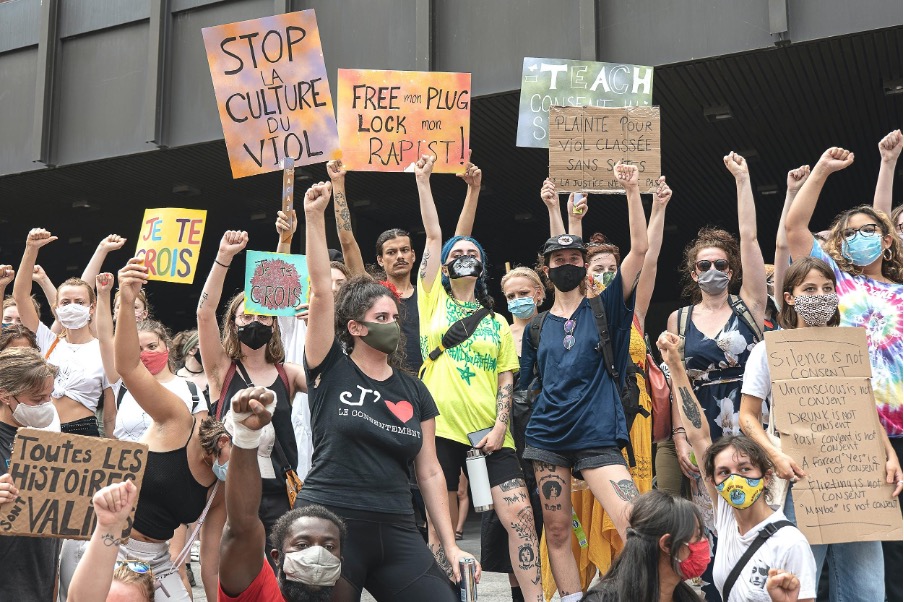

 Following the UN’s 16 Days of Activism against Gender-based Violence, Elena Martellozzo, Paula Bradbury and Emma Short explain why more needs to be done to tackle gender-based cyber violence.
Following the UN’s 16 Days of Activism against Gender-based Violence, Elena Martellozzo, Paula Bradbury and Emma Short explain why more needs to be done to tackle gender-based cyber violence.
From 25 November to 10 December 2021 the United Nations marked the 16 Days of Activism against Gender-based Violence, under the global theme set by the UN Secretary-General’s UNiTE campaign: “Orange the World: End Violence against Women Now!”. Our staff at the Centre of Abuse and Trauma Studies (CATS) at Middlesex University, along with close friends and colleagues, have worked consistently at an international level to support women and girls who are victimised online. They have participated in major events to share empirical evidence, raise awareness, and to support governmental organisations who are working to stop gender-based cyber violence against women and girls.
As defined by the European Institute for Gender Equality (EIGE), a regulatory agency of the European Union, cyber gender-based violence includes “all forms of violence perpetrated through electronic communication and the internet”. The Centenary Action Group, which campaigns for equal representation of women in the UK parliament, argues that online violence against women and girls “should be recognised as a wide and growing set of harms including intimate image abuse, online harassment, the sending of unsolicited explicit images, coercive ‘sexting’, the creation and sharing of ‘deepfake’ pornography.”
Evidence at both global and regional level shows that women and girls are particularly affected by this phenomenon, being exposed to high levels of online violence, and its impact can be devastating. However, as argued by Dame Vera Baird, the victims’ commissioner for England and Wales, more needs to be done because “women are simply not being protected by the criminal justice system”. Ninety-nine percent of those exploited for financial gain are women, and one in five are girls (Plan International, 2021), with children in care and children with special educational needs being amongst the most vulnerable (NSPCC, 2021). An estimated 50% of female sex workers in the UK began being paid for sex acts before they were 18 years old, according to Women’s Liberation Now.
What is being forgotten is that women continue to be sexually exploited after they turn 18 years old. This issue was raised in the Chief Social Worker’s Annual Report 2019 -2020 which stated:
“It’s important to remember this does not stop at eighteen and is not an issue which children’s services can tackle alone – our safeguarding services need a different response. Unfortunately, they are often configured in ways which do not support young people after the age of eighteen unless they have a disability.”
Some women are specifically targeted at the age of 18+ as abusers know that safeguarding provisions diminish at that point, and the definition of the exploitation changes from the sexual abuse of a child to a sexual choice made by the woman. However, according to the UK government’s strategy, in order to tackle sexual violence against women and girls, the focus should not be about the age of the victims, it should be about vulnerability and the imbalance of power between the victim and their abuser that is utilised for the purpose of sexual exploitation. Some of the most vulnerable women are those from ethnic minority communities, women engaging in sex work, women with disabilities and victims of domestic abuse.
During these 16 days of activism, we have seen governments and organisations, including NGOs, creating opportunities to voice, share and debate how the key factors that aggravate cyber violence against women can be challenged.
On 24 November 2021, Professor Clare McGlynn QC (Hon) presented at the Lincolns’ Inn Equality, Diversity and Inclusion Forum, on “the Boundaries of Intimate Image Abuse: where next for law reform?” Claire presented on a number of uncomfortable types of cyber violence, including cyberflashing, a form of sexual intimidation that can make women feel fearful for their physical safety, as well as feeling violated and humiliated which can lead to considerable distress and anxiety.
The following day, the Finnish Ministry of Justice invited us – Dr Emma Short, Dr Elena Martellozzo and Paula Bradbury – to present a discussion paper on “digital violence: understanding the growing threat to women and girls in cyberspace”. We explained how online violence and abuse against women and girls has grown over the past two years, as lockdowns moved the world online. However, risks associated with cyber violence against women and girls may be overlooked, as they are often not considered ‘real violence’.
Dr Elena Martellozzo argued that separating cyber violence from ‘real world’ violence can be dangerous because of the negative and harmful effects that online violence has on women and girls. There is a risk that because these crimes take place virtually, they could be dismissed as less damaging for women and girls than physical violence. However, being online creates opportunities for crimes like cyberstalking, cyberharassment and online grooming to be enacted easily, rapidly and anonymously. The ‘always on’, omni-connected nature of modern life means that perpetrators have the potential to target individuals, particularly women and girls, perfidiously.
Dr Emma Short presented some evidence suggesting that there has been an increase in stalking behaviours experienced by victims, and changes in stalking behaviour in the year ending April 2021. She argues that changes in the patterns of stalking behaviour present new challenges for advocates and frontline police officers, emphasising the necessity not only to understand the changing landscape from their perspective, but also how the problem is policed and the victims are supported.
Paula Bradbury talked about the victimisation of children and young people online and presented some of the evidence collected on women selling nudes during the lockdown on sites such as OnlyFans. She explained that some young, vulnerable women, in financial difficulties, were compelled to sell their bodies online, and perform sexual acts requested by subscribers to maintain their interest, increase their popularity, and earn more money. Acknowledging that such sites reduce many of the risks to women who work in the offline sex industry, Bradbury argued that they also create the opportunity to exploit women and girls for financial gain in plain sight.
Call for further changes
“The construction, perception and communication of hate is primarily social”, claimed Dr Eleonora Esposito during the Stakeholder Consultation Meeting on mapping cyberviolence in Europe, organised by EIGE on 2 December 2021. It is therefore important that we do not focus exclusively on the role played by social media and, as a result, overlook our civil responsibilities. We, as social media users, should be held accountable for utilising those platforms maliciously, to harm others, and these messages should be clear to all users through perhaps, an online an online code of conduct, that highlights the importance of online safety.
Furthermore, it is important “to advance the status quo on gender-based violence”, claims Dr Esposito, by developing common definitions that will allow researchers to measure the phenomenon. Only what is measured becomes visible, and what is visible can in turn be monitored, and only what is monitored can be improved. In other words, the lack of understanding of the gravity that cyber violence has on women and girls may lead to inadequate responses from police authorities, for example making women who experienced online harassment feel responsible for “putting the information online in the first place”.
We have observed that there is also a tendency to place the responsibility for cyber violence on victims rather than abusers. This attitude only serves to enable the prevalence of exploitation and risks to women, girls, and other vulnerable victims and reduces their willingness to report their abuse. More than a third of women worldwide have experienced abuse online, rising to almost half for younger women (classified as Generation Z and Millennials), according to a 2021 study from the Economist Intelligence Unit. While individual efforts are important for immediate damage control, we call for significant changes to be made by a variety of stakeholders, including governments and the tech industry. We ask for changes that do not only provide the necessary legal framework to support the voices of women, girls, and other vulnerable people who are exploited online, but practical measures that prevent and challenge those who seek to exploit.
Some of the significant changes should include:
- The advancement of the status quo on cyber gender-based violence by developing common definitions of cyber gender-based violence, so we can measure specific issues with precision
- The development of an online code of conduct, particularly in the workplace
- Implementation by government of a comprehensive public health approach to tackling online abuse
- Updated training and appropriate resourcing for front line workers to tackle cases of online violence
- More pressure placed on tech companies by governments to do more to tackle online abuse
- Tech companies to provide greater transparency about their content moderation efforts and to invest more resources in human content moderation.
This article gives the views of the authors and does not represent the position of the Media@LSE blog, nor of the London School of Economics and Political Science.
Featured image: Photo by Kev Costello on Unsplash





